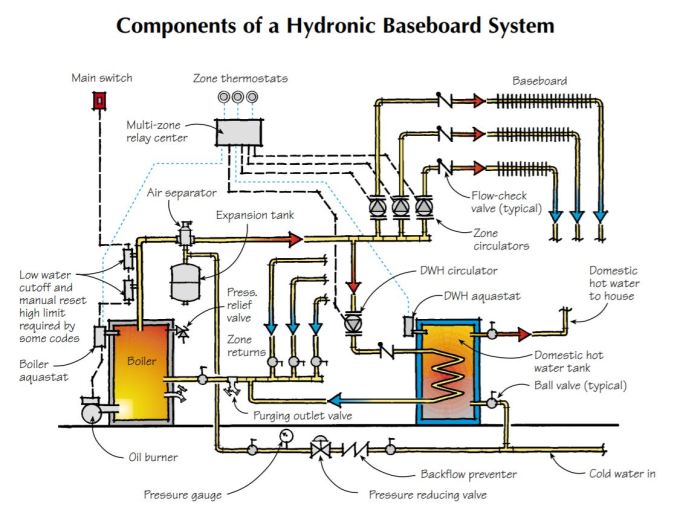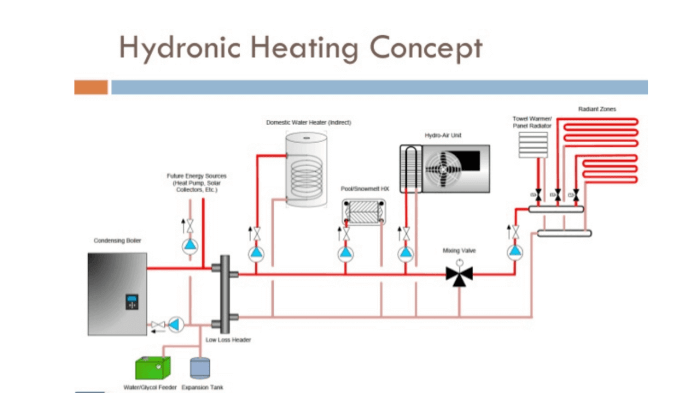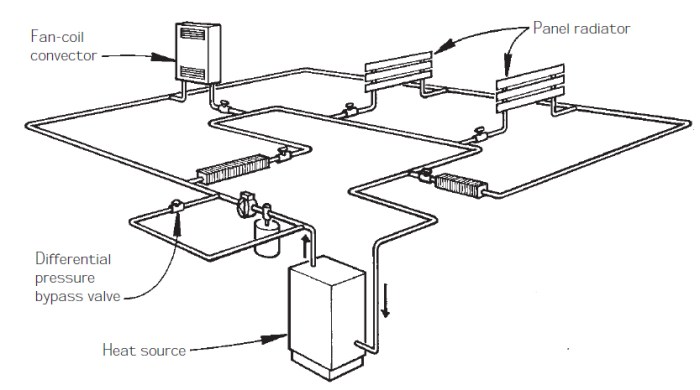The basic hydronic heating system diagram serves as a visual representation of a system that utilizes heated water to provide warmth and comfort within a structure. This intricate network of components, including the boiler, pump, pipes, and radiators, works in unison to circulate hot water throughout the building, ensuring an efficient and reliable heating solution.
Understanding the intricacies of a basic hydronic heating system diagram empowers homeowners and professionals alike to make informed decisions regarding the installation, maintenance, and operation of these systems. By exploring the various components and their functions, we gain a comprehensive insight into the mechanisms that deliver warmth and coziness to our living spaces.
System Overview
A hydronic heating system is a central heating system that uses hot water to heat a building. The system consists of a boiler, a pump, pipes, and radiators. The boiler heats the water, the pump circulates the water through the pipes, and the radiators release the heat into the air.
There are two main types of hydronic heating systems: one-pipe systems and two-pipe systems. In a one-pipe system, the same pipe is used to supply hot water to the radiators and return the cooled water to the boiler. In a two-pipe system, there is a separate pipe for the supply and return water.
Here is a basic diagram of a hydronic heating system:
- Boiler
- Pump
- Pipes
- Radiators
Boiler Operation

The boiler is the heart of a hydronic heating system. It is responsible for heating the water that circulates through the system. There are many different types of boilers, but the most common type is the gas-fired boiler. Gas-fired boilers burn natural gas to heat the water.
Here is a diagram of a boiler:
- Burner
- Heat exchanger
- Water inlet
- Water outlet
Pump Operation

The pump is responsible for circulating the water through the hydronic heating system. There are many different types of pumps, but the most common type is the centrifugal pump. Centrifugal pumps use a rotating impeller to move the water.
Here is a diagram of a pump:
- Impeller
- Shaft
- Housing
- Water inlet
- Water outlet
Piping and Radiators

The pipes in a hydronic heating system carry the hot water from the boiler to the radiators. The most common type of pipe used in hydronic heating systems is copper pipe. Copper pipe is durable and resistant to corrosion.
The radiators in a hydronic heating system release the heat from the water into the air. There are many different types of radiators, but the most common type is the baseboard radiator. Baseboard radiators are mounted on the floor along the walls of the room.
Controls
The controls in a hydronic heating system regulate the temperature of the water in the system. The most common type of control is the thermostat. Thermostats sense the temperature of the air in the room and turn the boiler on or off accordingly.
Other types of controls used in hydronic heating systems include zone valves and actuators. Zone valves control the flow of water to different zones in the system. Actuators open and close the zone valves.
Here is a diagram of a control system:
- Thermostat
- Zone valve
- Actuator
Installation and Maintenance: Basic Hydronic Heating System Diagram

The installation of a hydronic heating system is a complex process that should be performed by a qualified professional. The maintenance of a hydronic heating system is relatively simple and can be performed by the homeowner.
Here are some tips for maintaining a hydronic heating system:
- Check the water pressure in the system regularly.
- Bleed the radiators of air regularly.
- Flush the system with clean water every few years.
- Have the boiler serviced by a qualified professional annually.
Quick FAQs
What are the advantages of a hydronic heating system?
Hydronic heating systems offer several advantages, including:
- Efficient heat distribution
- Quiet operation
- Zoning capabilities
- Reduced energy consumption
How does a hydronic heating system work?
A hydronic heating system circulates hot water through pipes embedded in the floor, walls, or ceiling. The heated water releases heat into the surrounding environment, warming the space. The water is then returned to the boiler to be reheated and recirculated.
What are the different types of hydronic heating systems?
There are two main types of hydronic heating systems:
- One-pipe systems
- Two-pipe systems
One-pipe systems use a single pipe to carry both hot water to the radiators and return water back to the boiler. Two-pipe systems use separate pipes for hot water supply and return.